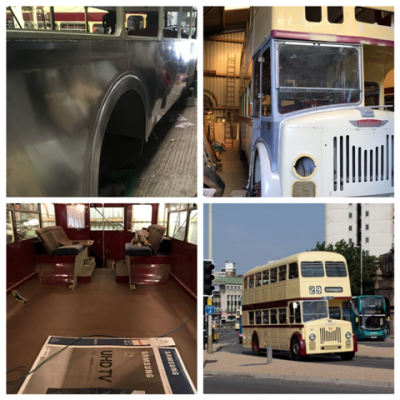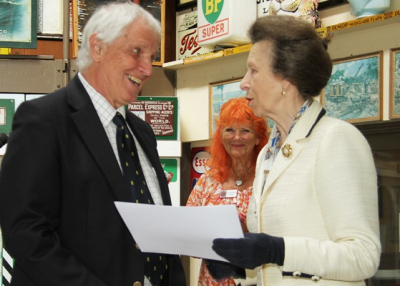The Trust offers financial assistance to individuals or groups to carry through restoration or improvement projects to completion. The Trust also invites enquiries about sponsoring one or more Awards.

Barry Ford
 Barry joined the Royal Navy at the age of 15 and served on a number of ships culminating in the Royal Yacht Britannia. On leaving the Navy he joined the Royal Navy Auxiliary Service, a voluntary organisation which was disbanded in 1993 at the end of the Cold War. Barry then joined the Maritime Volunteer Service and also volunteered on the Steamship Shieldhall. From there he joined the team on HMS Medusa in 1998. Medusa is a Harbour Defence Launch built in 1943 and is part of the National Historic Fleet. When Barry joined the vessel, her condition was in decline, and he helped return her to sea-worthiness. He took the engineering lead, getting everything working again, and, at sea, manning the engine room. Medusa is operated by telegraph between the bridge and engine room; the engineer has to monitor this and operate the engines in response. It's a demanding job as any error in a tight manoeuvre can be disastrous. Medusa took part in the 2005 fleet review with Barry running the engine room.
Barry joined the Royal Navy at the age of 15 and served on a number of ships culminating in the Royal Yacht Britannia. On leaving the Navy he joined the Royal Navy Auxiliary Service, a voluntary organisation which was disbanded in 1993 at the end of the Cold War. Barry then joined the Maritime Volunteer Service and also volunteered on the Steamship Shieldhall. From there he joined the team on HMS Medusa in 1998. Medusa is a Harbour Defence Launch built in 1943 and is part of the National Historic Fleet. When Barry joined the vessel, her condition was in decline, and he helped return her to sea-worthiness. He took the engineering lead, getting everything working again, and, at sea, manning the engine room. Medusa is operated by telegraph between the bridge and engine room; the engineer has to monitor this and operate the engines in response. It's a demanding job as any error in a tight manoeuvre can be disastrous. Medusa took part in the 2005 fleet review with Barry running the engine room.
Immediately after the review, she began a 5 year refit funded by the Heritage Lottery. The engines were lifted out and moved to a workshop. Barry led the volunteer effort stripping and rebuilding both engines to a high standard, only to have his work undone when the engines were damaged by a fire at the workshop. It would have been easy to give up at that stage, but he stuck with it and motivated others to do so as well. The refit was completed in 2010 and the vessel launched and rededicated by Her Royal Highness, The Princess Royal. At this time Barry moved from the engine room to the deck side and became a watch officer; while on watch he was in charge of the vessel. When not at sea, Barry was a key figure in maintaining the vessel and could do anything from rope work through painting to fabrication of parts.
 Over the last eight years Barry has been the vessel's cox'n, a responsible role as the senior crew member. Barry allocates crew roles and trains the crew in their duties. As the most experienced helmsman, he is on the wheel for entering and leaving harbour. Operating Medusa involves close team work and trust between the skipper, cox’n and engineer. Barry is faultless in his helm work.
Over the last eight years Barry has been the vessel's cox'n, a responsible role as the senior crew member. Barry allocates crew roles and trains the crew in their duties. As the most experienced helmsman, he is on the wheel for entering and leaving harbour. Operating Medusa involves close team work and trust between the skipper, cox’n and engineer. Barry is faultless in his helm work.
The Medusa team has also played a part in saving RML497, a Fairmile launch now at Hartlepool, as well as helping the Coastal Forces Trust and the Royal Navy Museum with the new Night Hunters museum at Priddy's Hard, Gosport. Barry played a full role in both projects.
At 87, Barry is still a very active member of Medusa's crew and is regarded by everyone as the father of the vessel; he has been with her for more than a quarter of a century. It is very appropriate that this service and dedication is recognised by this lifetime achievement award.
Martin Southam and Karl Tecklenberg
Leyland PD3 double-decker bus TBC163 was registered and entered service in Leicester in 1958, staying in service until 1974. After some time out of use it became a driver-training vehicle until in 1981 it was sold and partly converted to a children's play-bus but never used. By 1991 it was free to anyone who would restore it and the Leicester Transport Heritage Trust brought it back to Leicester.

It was in a bit of a state to say the least, with rotten bulkheads, most handrails and poles missing or bent, no seats, fluorescent lights cut into the ceiling coving panels, no floor coving, a hole in the upstairs floor above the engine bay to accommodate a slide, missing glazing and a hole in the nearside bodywork where a cupboard had been created to house gas bottles as part of the unfinished play bus conversion. On the plus side it had an aluminium framed body that was otherwise in good condition. This is what saved the bus.

Stripping off paint and lower panels was the easy part. Repairing the damage to the roof where strip lights had been installed was not. But these were not the only modifications; as a driver-training vehicle it had had the bulkhead behind the driver removed and this complex glass panel had been lost. Fortunately a panel was located from a donor vehicle and this allowed the team to recreate the bulkhead.
Mechanically the vehicle was sound, with only re-commissioning required. The interior was another matter: no seats, hand rails or floor coverings. Hand rails were made, painting completed, windows made to work and refitted with new rubber. Neither did it have any interior lighting, bell or bell pushes. Suitable replacements were found in the Trust’s stores.
Seats should have been easy surely? But who knew that in 1968 when the maximum permitted width of a bus increased from 8 feet to 8 feet 2.5 inches, that the width of seats changed from 34 inch 35inch! TBC 163 needed 34†and they were not easy to find. Covering the 34 inch seats was a further challenge: leather was too expensive and the vinyl later used by Leicester City Transport was now out of production. 50 metres of something close was ordered which the trimmer installed in three weeks.
Metal floor strips needed de-rusting, cutting to size, priming, undercoating, top coating, drilling and countersinking before they could be fitted. Over 1,500 holes were drilled before small screws were used to fix them in place, each screw inserted and tightened in by hand. By the time of the successful MOT test, 26 years had elapsed.
Of the original members of the TBC163 group most have had to stand down, though new members have joined. Of that whole group of 10, the only two who have been there from beginning to end are our Lifetime Achievemment Award winners today Karl Tecklenberg and Martin Southam.
Oliver Heal
Pictured below is Mike Lunch receiving the Lifetime Achievement Award on behalf of Oliver Heal who was unable to be at the presentation cermenony.

Son of Anthony Heal, Oliver grew up immersed in his father's passion for Transport Heritage. Dad owned the 14-ton steam traction engine Boadicea, and it was Oliver's task to light the kindling in the boiler each morning when they were on an extended trip. His father rescued many of the historic Sunbeam racing cars and started a collection of historic Sunbeam photographs, reference materials and correspondence which Oliver has researched and expanded over the last 30 years.
Like his father, Oliver is a quiet character, but a mine of information on Sunbeam's racing cars, where they competed, results and where the cars are now. Anthony was a founder member of Vintage Sports Car Club (VSCC) and remained close to the club throughout his life. He needed a suitable vehicle as family transport and to enter VSCC events so he purchased a 3 litre Super Sports Sunbeam, YP 7363, used for work, family trips and motor racing.
Upon Antony's death, Oliver took over the care of YP and lovingly maintained it for most of his life, attending many events and competitions. It is a huge credit to Oliver that YP is one of the most original 3 litres. Oliver has resisted any restoration, pursuing a careful maintenance programme which has resulted in a car often used as a reference for originality. His car is a regular sight both at competitions and social events. Oliver's wife Annik is granddaughter of Louis Coatalen, the gifted French engineer responsible for Sunbeam's most successful racing and land speed record cars. Oliver researched the family archive and wrote an award-winning biography of Louis Coatalen, published in March 2020.

Recognised world-wide as the pre-eminent Sunbeam Historian, Oliver has written many articles for transport heritage magazines. In 2022 he was a key member of the team that brought together National Motor Museum, Sunbeam Talbot Darracq Register and National Transport Trust to celebrate the centenary of the 350hp Sunbeam's Land Speed Record at Brooklands. Oliver delivered a historical talk to a VIP audience which included the descendants of Kenelm Lee Guinness, Malcolm Campbell and Louis Coatalen.
The National Transport Trust makes loans to groups, associations and individuals at advantageous rates for the restoration of artefacts - whether mobile or part of the infrastructure. Applications must be supported by a simple business plan which demonstrates the financial viability of the project. A sample business plan is available on request from the Treasurer.
The Trust does occasionaly make Awards for schemes which further the preservation movement. Again if you wish further information please contact the Treasurer.